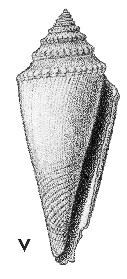
Revised descriptions of New Zealand Cenozoic Mollusca from Beu and Maxwell (1990)

 | Revised descriptions of New Zealand Cenozoic Mollusca from Beu and Maxwell (1990) | 
|
  (Pl. 22v): GS9500, J41/f8028, excavation for Oamaru Borough Council septic tank, South Oamaru, Altonian (GNS) |
Beu & Maxwell (1990): Chapter 11; p. 207; pl. 22 v.
Synonymy: Conus ornatus Hutton 1873b, p. 10 (not of Michelotti, 1847); Hemiconus trailli "(Hutton)" of Finlay 1924a, p. 105 (in part not Conus trailli Hutton 1873b, p. 10, not of A. Adams, 1855, = Conus huttoni Tate 1890, p. 189, = Conospira bimutata Finlay 1924d, p. 498); Conospirus huttoni "(Tate)" of Olson in Gage 1957, p. 126 (in part not Conus huttoni Tate, 1890); Conilithes wollastoni Maxwell 1978, p. 42-43 (new name for Conus ornatus Hutton, 1873, preoccupied); Hemiconus ornatus
Classification: Conidae: Coninae
Description: Rather small to moderate-sized for family (height 20-45 mm), biconic, spire 0.25-0.3 total height. Protoconch narrowly conical, of about 4 smooth whorls. Teleoconch of 8-9 whorls, angled below middle on spire, some shells with angulation just above suture, sutural ramp flat or slightly concave; last whorl straight or weakly excavated. Axial sculpture typically of small, squarish, opisthocline nodules on periphery, extending a short distance anteriorly but obsolete on ramp; 23-29 nodules on penultimate whorl. Some shells with nodules confined to first 4 whorls or so. Sutural ramp with thin, arcuate growth ridges. Spiral sculpture on spire whorls of 2-4 narrow cords on periphery and a few weak threads on ramp; last whorl with 11-14 well denned narrow grooves on anterior half or less, remainder smooth except for 1 or 2 weakly defined grooves on some shells. Aperture narrow, rectangular with inner and outer lips almost parallel and straight. Outer lip thin with shallow, arcuate sinus on ramp.
Comparison: Conilithes wollastoni is the best-known New Zealand cone. It has long been identified as Conus (or Conospirus) huttoni, but the type specimen of that species (the only one known) has only weak nodules on the early teleoconch whorls, and has distinct spiral grooves over the whole of the last whorl below the periphery. C. rivertonensis (Altonian, Southland) is more slender and higher-spired than C. wollastoni, and has the shoulder angle situated higher up on later whorls. C. oliveri (Clifdenian, Gisborne district) is similar in shape to C. wollastoni, but has a larger and more narrowly conical protoconch. A recent analysis of Conus coxI-coxII intergeneric sequences (Bandyopadhyay et al., 2008) established that there are two groups of "Conus" species throughout the world ocean, the taller-spired species consistently falling out as a phylogenetic entity separate from Conus, so Conospirus might well prove to be the earliest name for the tall-spired genus, although at present it is uncertain whether this is the correct name for the genus.
Distribution: Altonian; Mount Harris Formation, Awamoa (type — probably from the former beach outcrop at the mouth of Awamoa Creek where it seems to have been very abundant) and other localities in North Otago and South Canterbury.
Cite this publication as: "A.G. Beu and J.I. Raine (2009). Revised
descriptions of New Zealand Cenozoic Mollusca from Beu and Maxwell (1990). GNS
Science miscellaneous series no. 27."
© GNS Science, 2009
ISBN
978-0-478-19705-1
ISSN 1177-2441
(Included with a PDF facsimile file
copy of New Zealand Geological Survey Paleontological Bulletin 58 in CD version
from: Publications Officer, GNS Science, P.O. Box 30368 Lower Hutt, New
Zealand)